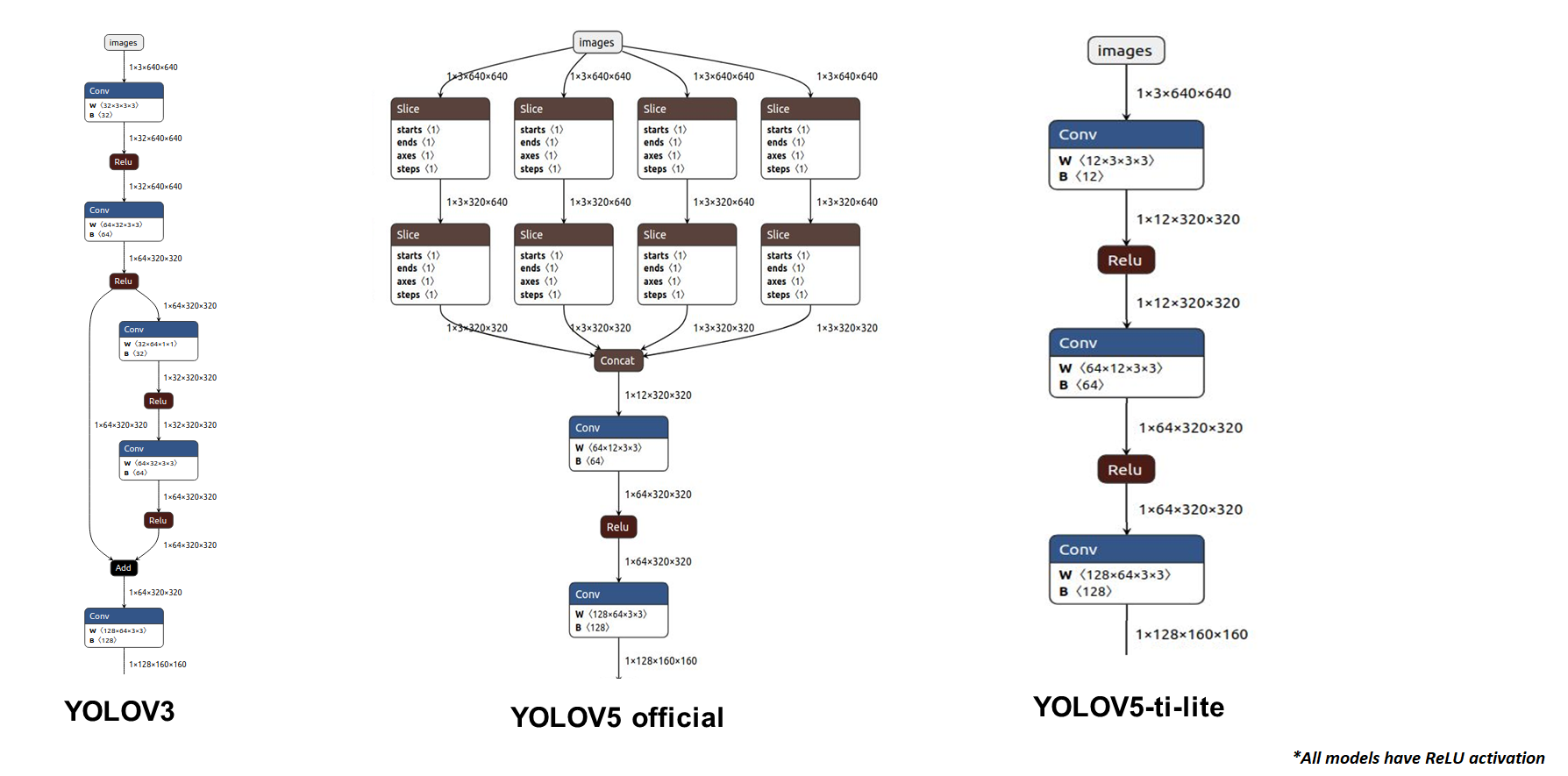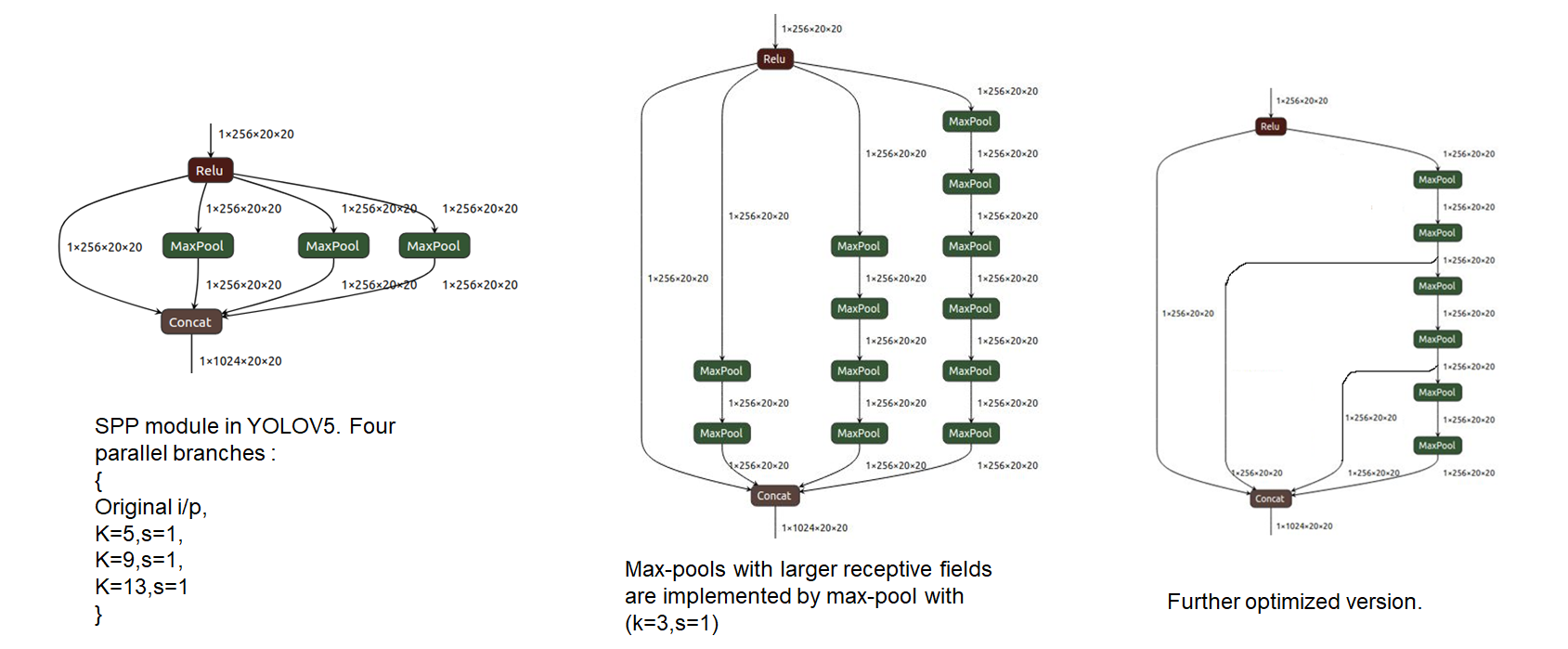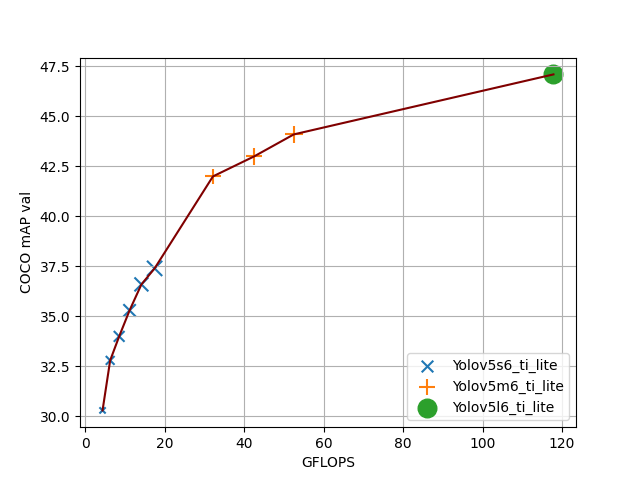This repository is based on ultralytics/yolov5. As per the Official Readme file from Ultralytics, YOLOV5 is a family of object detectors with the following major differences from YOLOV3:
- Darknet-csp backbone instead of vanilla Darknet. Reduces complexity by 30%.
- PANet feature extractor instead of FPN.
- Better box-decoding technique
- Genetic algorithm based anchor-box selection.
- Several new augmentation techniques. E.g. Mosaic augmentation
| Dataset | Model Name | Input Size | GFLOPS | AP[0.5:0.95]% | AP50% | Notes |
|---|---|---|---|---|---|---|
| COCO | Yolov5s6 | 1280x1280 | 69.6 | 43.3 | 61.9 | |
| COCO | Yolov5s6_640 | 640x640 | 17.4 | 38.9 | 56.8 | (Train@ 1280, val@640) |
| COCO | Yolov5m6 | 1280x1280 | 209.6 | 50.5 | 68.7 | |
| COCO | Yolov5m6_640 | 640x640 | 52.4 | 45.4 | 63.6 | (Train@ 1280, val@640) |
| COCO | Yolov5l6 | 1280x1280 | 470.8 | 53.4 | 71.1 | |
| COCO | Yolov5l6_640 | 640x640 | 117.7 | 49.0 | 67.0 | (Train@ 1280, val@640) |
-
YOLOV5-ti-lite is a version of YOLOV5 from TI for efficient edge deployment. This naming convention is chosen to avoid conflict with future release of YOLOV5-lite models from Ultralytics.
-
Here is a brief description of changes that were made to get yolov5-ti-lite from yolov5:
- YOLOV5 introduces a Focus layer as the very first layer of the network. This replaces the first few heavy convolution layers that are present in YOLOv3. It reduces the complexity of the n/w by 7% and training time by 15%. However, the slice operations in Focus layer are not embedded friendly and hence we replace it with a light-weight convolution layer. Here is a pictorial description of the changes from YOLOv3 to YOLOv5 to YOLOv5-ti-lite:
-
SiLU activation is not well-supported in embedded devices. it's not quantization friendly as well because of it's unbounded nature. This was observed for hSwish activation function while quantizing efficientnet. Hence, SiLU activation is replaced with ReLU.
-
SPP module with maxpool(k=13, s=1), maxpool(k=9,s=1) and maxpool(k=5,s=1) are replaced with various combinations of maxpool(k=3,s=1).Intention is to keep the receptive field and functionality same. This change will cause no difference to the model in floating-point.
- maxpool(k=5, s=1) -> replaced with two maxpool(k=3,s=1)
- maxpool(k=9, s=1) -> replaced with four maxpool(k=3,s=1)
- maxpool(k=13, s=1)-> replaced with six maxpool(k=3,s=1) as shown below:
-
Variable size inference is replaced with fixed size inference as preferred by edge devices. E.g. tflite models are exported with a fixed i/p size.
- Training any model using this repo will take the above changes by default. Same commands as the official one can be used for training models from scartch. E.g.
python train.py --data coco.yaml --cfg yolov5s6.yaml --weights '' --batch-size 64 yolov5m6.yaml - Yolov5-l6-ti-lite model is finetuned for 100 epochs from the official ckpt. To replicate the results for yolov5-l6-ti-lite, download the official pre-trained weights for yolov5-l6 and set the lr to 1e-3 in hyp.scratch.yaml
python train.py --data coco.yaml --cfg yolov5l6.yaml --weights 'yolov5l6.pt' --batch-size 40 - Pretrained model checkpoints along with onnx and prototxt files are kept inside pretrained_models.
- Run the following command to replicate the accuracy number on the pretrained checkpoints:
python val.py --data coco.yaml --img 640 --conf 0.001 --iou 0.65 --weights pretrained_models/yolov5s6_640_ti_lite/weights/best.pt yolov5m6_640_ti_lite yolov5l6_640_ti_lite
| Dataset | Model Name | Input Size | GFLOPS | AP[0.5:0.95]% | AP50% | Notes |
|---|---|---|---|---|---|---|
| COCO | Yolov5s6_ti_lite_640 | 640x640 | 17.48 | 37.4 | 56.0 | |
| COCO | Yolov5s6_ti_lite_576 | 576x576 | 14.16 | 36.6 | 55.7 | (Train@ 640, val@576) |
| COCO | Yolov5s6_ti_lite_512 | 512x512 | 11.18 | 35.3 | 54.3 | (Train@ 640, val@512) |
| COCO | Yolov5s6_ti_lite_448 | 448x448 | 8.56 | 34.0 | 52.3 | (Train@ 640, val@448) |
| COCO | Yolov5s6_ti_lite_384 | 384x384 | 6.30 | 32.8 | 51.2 | (Train@ 384, val@384) |
| COCO | Yolov5s6_ti_lite_320 | 320x320 | 4.38 | 30.3 | 47.6 | (Train@ 384, val@320) |
| COCO | Yolov5m6_ti_lite_640 | 640x640 | 52.5 | 44.1 | 62.9 | |
| COCO | Yolov5m6_ti_lite_576 | 576x576 | 42.52 | 43.0 | 61.9 | (Train@ 640, val@576) |
| COCO | Yolov5m6_ti_lite_512 | 512x512 | 32.16 | 42.0 | 60.5 | (Train@ 640, val@512) |
| COCO | Yolov5l6_ti_lite_640 | 640x640 | 117.84 | 47.1 | 65.6 | This model is fintuned from the official ckpt for 100 epochs |
There are three models in the pretrained_models. All other results are generated for these model on a different resolution. In order to generate the accuracy number at 512x512, run the following:
python test.py --data coco.yaml --img 512 --conf 0.001 --iou 0.65 --weights pretrained_models/yolov5s6_640_ti_lite/weights/best.pt
yolov5m6_640_ti_lite
yolov5l6_640_ti_lite
- Run the following command to export the entire models including the detection part,
python export.py --weights pretrained_models/yolov5s6_640_ti_lite/weights/best.pt --img 640 --batch 1 --simplify --export-nms --opset 11 # export at 640x640 with batch size 1
- Apart from exporting the complete ONNX model, above script will generate a prototxt file that contains information of the detection layer. This prototxt file is required to deploy the moodel on TI SoC.
[1] Official YOLOV5 repository
[2] yolov5-improvements-and-evaluation, Roboflow
[3] Focus layer in YOLOV5
[4] CrossStagePartial Network
[5] Chien-Yao Wang, Hong-Yuan Mark Liao, Yueh-Hua Wu, Ping-Yang Chen, Jun-Wei Hsieh, and I-Hau Yeh. CSPNet: A new backbone that can enhance learning capability of
cnn. Proceedings of the IEEE Conference on Computer Vision and Pattern Recognition Workshop (CVPR Workshop),2020.
[6]Shu Liu, Lu Qi, Haifang Qin, Jianping Shi, and Jiaya Jia. Path aggregation network for instance segmentation. In Proceedings of the IEEE Conference on Computer Vision and Pattern Recognition (CVPR), pages 8759–8768, 2018
[7] Efficientnet-lite quantization
[8] [YOLOv5 Training video from Texas Instruments] (https://training.ti.com/process-efficient-object-detection-using-yolov5-and-tda4x-processors)


